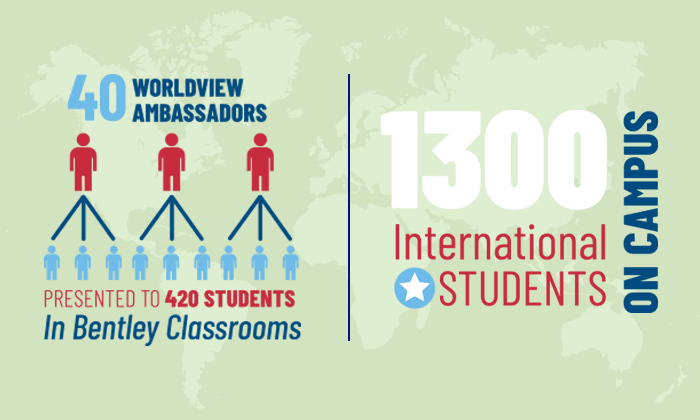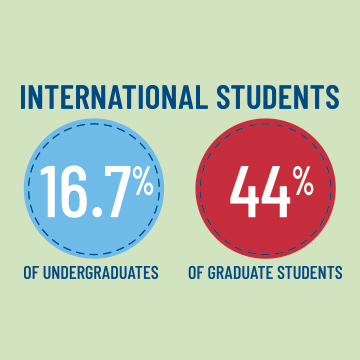
There is more to cultural understanding than appreciating another country’s cuisine or clothing. Meaningful connections are more likely forged through personal stories about daily life and experiences in other countries. That is the inspiration for a program offered through the Center for International Students and Scholars (CISS).
“The WorldView program aims to promote global awareness, intercultural sensitivity and unity within the campus community,” says CISS Assistant Director Nia DeYounge, who manages the program with help from graduate intern Stephen Perkins.
The initiative sends international student “ambassadors” into Bentley classrooms for a panel discussion or presentation related to course topics.
ALL THE RIGHT MOVES
When Professor of History Cyrus Veeser was teaching a course in Caribbean history with travel to the Dominican Republic, he envisioned a presentation on the country’s culture, daily life, music and dance  — including basic lessons in bachata, merengue and salsa. Dominican-born Jessica Ortega Weber, MSF ’18 stepped in.
— including basic lessons in bachata, merengue and salsa. Dominican-born Jessica Ortega Weber, MSF ’18 stepped in.
“Jessica talked about Dominican culture, particularly social interactions, hospitality and the importance of sharing experiences,” explains the professor, noting that his students put the dance steps to good use, in working alongside teachers at a public school in La Romana and a school for the deaf.
“Students were thrilled that the Bentley volunteers were willing to dance with them,” says Veeser. “It is very bad form to refuse to dance in the Dominican Republic, and Jessica’s lessons definitely gave my group some added confidence.”
Associate Professor of Management Iris Berdrow has invited ambassadors to speak in three courses: Human Behavior in Organizations, International Management Behavior and Global Leadership. She encourages presenters to describe how the Bentley experience compares with that of their home country; their reflections speak to course topics such as national culture, diversity, privilege/marginalization, perception and communication.
Says Berdrow: “It’s one thing to discuss how cultural upbringing and conditions shape our understanding of the world. But these points come to life when students hear their international peers talk about personal experiences and perspectives.”
ENGAGING CONVERSATION
With roots in India and Singapore, Deepa Chandrachud ’19 routinely offers her perspective in conversations with her American peers. She calls the more formal platform of the WorldView program “an opportunity I couldn’t miss.”
One memorable engagement: a panel discussion for a management course about diversity in the workplace.
 “The work culture in Singapore is very different because there is hardly any time spent on training,” explains Chandrachud, who did an internship there in her sophomore year. “We also don’t do a lot of networking.”
“The work culture in Singapore is very different because there is hardly any time spent on training,” explains Chandrachud, who did an internship there in her sophomore year. “We also don’t do a lot of networking.”
The learning was mutual, she adds. “It turned into an engaging conversation among all the students. Taking part in classroom discussions about globalization affecting the business environment has been invaluable. It taught me the importance of providing a different perspective when facing an issue.”
In an especially valuable panel, for the University Police department, international students talked about media portrayal of the police and protocols in their respective countries. For example, a driver pulled over in Russia and China is encouraged to leave the car and approach the officer; doing so in the U.S. is unacceptable, if not dangerous. The learning prompted University Police to develop a web page explaining simple police protocols in the United States.
“WorldView lets us talk about culture in terms of day-to-day life,” says DeYounge. “Something like being pulled over by the police is part of American culture that people may not think about as international students adjust to a new country. Conversations like these are prompting deeper understanding and changing that.”
All figures are for 2017-2018.

